Table of Contents
When it comes to flat roofs, choosing the right roofing material is crucial. Flat roofs come with their own set of challenges, such as ponding water, leaks, and limited drainage. These issues can lead to serious damage and costly repairs if not addressed properly. So, can you put a metal roof on a flat roof? The answer is yes! Metal roofs can be an excellent choice for flat roofs when installed correctly.
In this article, we’ll explore the world of metal roofing and how it can be a game-changer for your flat roof. We’ll dive into the characteristics of flat roofs, the advantages of metal roofing systems, and the installation process. By the end of this article, you’ll clearly understand whether a metal roof is the right choice for your flat roof.
Understanding Flat Roofs
First things first, let’s define what a flat roof is. A flat roof is a roof that has a slope of less than 10 degrees. While they’re called “flat,” these roofs have a slight slope to allow for water drainage. Flat roofs are common in commercial buildings, but they can also be found in some residential homes.
Now, let’s talk about the common issues associated with flat roofs. Ponding water is a big one. When water accumulates on a flat roof and doesn’t drain properly, it can lead to leaks and water damage. This is why proper drainage is so important. Flat roofs also have limited drainage options compared to sloped roofs, which can make it harder to deal with water buildup.
Leaks and water damage are other common problems with flat roofs. When water seeps through the roofing material, it can cause damage to the underlying structure and lead to costly repairs. This is why it’s so important to choose a roofing material that can withstand the elements and keep your building protected.
Proper installation and maintenance are key when it comes to flat roofs. A poorly installed roof can lead to a host of problems down the line. Make sure you work with experienced professionals who know how to properly install and maintain your flat roof. Regular inspections and maintenance can help catch small issues before they turn into big problems.
Feasibility Study
Before you dive into installing a metal roof on your flat roof, it’s important to do a feasibility study. This will help you determine if a metal roof is the right choice for your building and if your roof structure can support it.
- First, assess your roof structure’s compatibility with a metal roof. Metal roofs are generally lighter than other roofing materials, but they still add weight to your roof. Make sure your roof structure can handle the additional weight of a metal roof. If you’re unsure, consult with a structural engineer who can assess your roof’s load-bearing capacity.
- Next, consider the weight implications of a metal roof. While metal roofs are lighter than some other roofing materials, they still add weight to your roof. This is especially important if you live in an area with heavy snowfall. The added weight of snow on top of a metal roof can put extra stress on your roof structure. Make sure your roof can handle the additional weight before moving forward with a metal roof.
- Finally, evaluate your existing drainage systems. Proper drainage is crucial for any flat roof, but it’s especially important when you’re installing a metal roof. Metal roofs are designed to shed water quickly, so you need to make sure your drainage systems can handle the increased water flow. If your current drainage system is inadequate, you may need to make upgrades before installing a metal roof.
By conducting a thorough feasibility study, you can ensure that a metal roof is the right choice for your flat roof and that your building is prepared for the installation process.

Metal Roofing Systems
Now that we’ve covered the basics of flat roofs and the importance of a feasibility study, let’s dive into the world of metal roofing systems.
Overview of metal roofing systems
Metal roofing systems are a popular choice for both residential and commercial buildings. They come in a variety of materials, styles, and colors, making them a versatile option for any building. Metal roofs are known for their durability, energy efficiency, and low maintenance requirements.
Advantages of metal roofs
- Durability and longevity: Metal roofs are built to last. They can withstand harsh weather conditions, including high winds, heavy rain, and even fire. With proper maintenance, a metal roof can last up to 50 years or more.
- Energy efficiency: Metal roofs are great for regulating your building’s temperature. They reflect heat in the summer, keeping your building cool, and they provide insulation in the winter, keeping your building warm. This can lead to significant energy savings over time.
- Fire resistance: Metal roofs are non-combustible, making them an excellent choice for areas prone to wildfires. They can help protect your building from flying embers and other fire hazards.
- Lightweight nature: Compared to other roofing materials, metal roofs are relatively lightweight. This can make them easier to install and put less stress on your building’s structure.
Different types of metal roofing materials
When it comes to metal roofing, you have plenty of options to choose from. Here are some of the most common types of metal roofing materials:
- Steel: Steel is a popular choice for metal roofs because it’s strong, durable, and relatively affordable. It’s also available in a variety of colors and styles.
- Aluminum: Aluminum is another popular choice because it’s lightweight, corrosion-resistant, and easy to work with. It’s a good choice for coastal areas where salt air can be a problem.
- Copper: Copper is a premium metal roofing material that’s known for its beauty and durability. It’s often used on historic buildings and high-end homes.
- Zinc: Zinc is a newer metal roofing material that’s gaining popularity because of its durability and low maintenance requirements. It’s also environmentally friendly because it’s 100% recyclable.
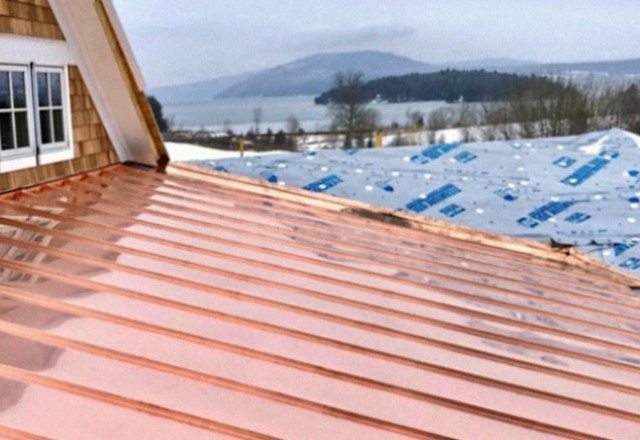
Can Metal Roofs be Installed on Flat Roofs?
One of the biggest misconceptions about metal roofs is that they’re only suitable for sloped roofs. But the truth is, metal roofs can be installed on flat roofs too!
Addressing the misconception
While it’s true that metal roofs are more commonly used on sloped roofs, they can be adapted for use on flat roofs as well. Metal roofs can be an excellent choice for flat roofs because of their durability and low maintenance requirements.
Factors to consider when installing a metal roof on a flat roof
- Proper slope and drainage: One of the most important factors to consider when installing a metal roof on a flat roof is proper slope and drainage. Metal roofs need to have a minimum slope of 1/4 inch per foot to ensure proper water runoff. Without adequate slope, water can pool on the roof and lead to leaks and other damage.
- Underlayment and waterproofing: Another important factor is underlayment and waterproofing. Because flat roofs are more prone to water damage, it’s crucial to install a high-quality underlayment and waterproofing system before installing the metal roof. This will help protect your building from leaks and moisture damage.
- Ventilation: Proper ventilation is also important when installing a metal roof on a flat roof. Without adequate ventilation, moisture can build up underneath the roof and lead to mold, mildew, and other problems. Make sure your roofing contractor installs proper ventilation to keep your building dry and healthy.
- Expansion and contraction: Metal roofs can expand and contract with temperature changes. This can be especially problematic on flat roofs where there’s nowhere for the metal to expand. Make sure your roofing contractor uses proper fastening techniques and allows for adequate expansion and contraction to prevent damage to your roof.
Importance of hiring experienced professionals for installation
Installing a metal roof on a flat roof is not a DIY project. It requires specialized knowledge, tools, and experience to ensure a proper installation. Hiring experienced professionals who specialize in metal roofing is crucial to ensure your roof is installed correctly and will last for years to come. Don’t skimp on quality when it comes to your roof – it’s one of the most important investments you can make in your building.
Slope Requirements
When it comes to installing a metal roof on a flat roof, slope requirements are crucial. Without a proper slope, water can pool on the roof and lead to leaks and other damage.
Minimum slope recommendations for metal roofs
The minimum slope recommendation for metal roofs is 1/4 inch per foot. This means that for every foot of horizontal distance, the roof should rise by at least 1/4 inch. However, some manufacturers may require a steeper slope for their specific products, so it’s important to consult with your roofing contractor and follow the manufacturer’s guidelines.
Roof Slope (in/ft) | Roof Pitch | Rise (in) | Run (in) | Angle (degrees) |
1/4 (minimum) | 1/48 | 1 | 48 | 0.60 |
1/2 | 1/24 | 1 | 24 | 2.39 |
3/4 | 1/16 | 1 | 16 | 3.58 |
1 | 1/12 | 1 | 12 | 4.76 |
1 1/2 | 1/8 | 1 | 8 | 7.13 |
2 | 1/6 | 1 | 6 | 9.46 |
2 1/2 | 1/5 | 1 | 5 | 11.31 |
3 | 1/4 | 1 | 4 | 14.04 |
4 | 1/3 | 1 | 3 | 18.43 |
5 | 5/12 | 5 | 12 | 22.62 |
6 | 1/2 | 1 | 2 | 26.57 |
This table provides a quick reference for understanding the relationship between roof slope, pitch, and rise and run measurements. It also includes the corresponding angle in degrees for each slope.
Key points:
- The roof slope is expressed as the number of inches the roof rises vertically for every 12 inches it runs horizontally.
- The roof pitch is another way to express the slope, showing the ratio of rise to run.
- The minimum recommended slope for metal roofs is 1/4 inch per foot, which equates to a pitch of 1/48 and an angle of 0.60 degrees.
- As the slope increases, the angle of the roof becomes steeper, which can impact the aesthetics and functionality of the metal roof.
Importance of slope for water runoff
A proper slope is essential for water runoff. When water can’t drain properly, it can pool on the roof and lead to leaks, corrosion, and other damage. A properly sloped metal roof will allow water to flow off the roof and into the gutters or drainage system, preventing water from accumulating on the roof surface.
Impact of Slope on Aesthetics and Functionality
Slope not only affects the functionality of your metal roof but also its aesthetics. A roof with a steeper slope will be more visible from the ground and can add visual interest to your building. However, a steeper slope may also be more challenging to install and maintain. It’s important to find a balance between functionality and aesthetics when choosing the slope for your metal roof.
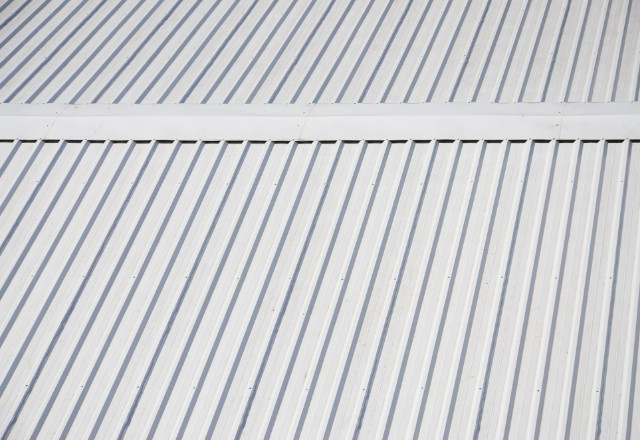
Drainage Solutions
Proper drainage is essential for any flat roof, but it’s especially important when installing a metal roof. Here are some drainage solutions to consider:
Installing tapered insulation for proper drainage
One way to improve drainage on a flat roof is to install tapered insulation. Tapered insulation is thicker at one end than the other, creating a slope that allows water to flow toward the drain or gutter. This can be an effective solution for flat roofs with poor drainage or ponding water.
Utilizing internal drains or scuppers
Another drainage solution is to utilize internal drains or scuppers. Internal drains are installed inside the building and connected to the roof’s drainage system. Scuppers are openings in the roof that allow water to drain off the side of the building. Both options can be effective for flat roofs with metal roofing systems.
Implementing overflow prevention mechanisms
To prevent water from overflowing and causing damage, it’s important to implement overflow prevention mechanisms. This can include installing overflow drains or scuppers, as well as ensuring that the roof’s drainage system is properly sized and maintained.
Challenges Faced
While metal roofing can be an excellent choice for flat roofs, there are some challenges to be aware of.
Ensuring proper installation on a flat surface
One of the biggest challenges of installing a metal roof on a flat surface is ensuring proper installation. Flat roofs require a different installation approach than sloped roofs, and it’s important to work with a contractor who has experience with flat roof installations.
Addressing potential water pooling issues
Even with proper slope and drainage, there’s still a risk of water pooling on a flat metal roof. This can be especially problematic in areas with heavy rainfall or snow. It’s important to work with your contractor to identify potential problem areas and develop solutions to prevent water pooling.
Handling expansion and contraction of metal
Metal roofs can expand and contract with temperature changes, which can be problematic on a flat roof. Without proper fastening and room for expansion, the metal can buckle or warp, leading to leaks and other damage. Make sure your contractor uses proper fastening techniques and allows for adequate expansion and contraction.
Thermal expansion rates of common metal roofing materials:
Metal Roofing Material | Linear Thermal Expansion Coefficient (in/in/°F) | Expansion per 100°F Temperature Change (in/100 ft) |
Aluminum | 0.0000123 | 1.23 |
Steel | 0.0000067 | 0.67 |
Copper | 0.0000094 | 0.94 |
Zinc | 0.0000170 | 1.70 |
Stainless Steel | 0.0000096 | 0.96 |
Galvalume | 0.0000070 | 0.70 |
This table provides valuable information for understanding the expansion and contraction properties of different metal roofing materials:
- The linear thermal expansion coefficient represents the amount of expansion per unit length of the metal for every degree Fahrenheit change in temperature.
- The expansion per 100°F temperature change shows how much the metal will expand over a 100-foot length when subjected to a 100°F temperature increase.
- Zinc has the highest expansion rate among the listed materials, while steel has the lowest.
- Aluminum and copper have relatively high expansion rates, while stainless steel and Galvalume have moderate expansion rates.
Installing a metal roof on a flat roof can be a smart investment for your building. With proper planning, installation, and maintenance, a metal roof can provide excellent protection against the elements while also improving your building’s energy efficiency and aesthetic appeal. If you’re considering a metal roof for your flat roof, make sure to work with experienced professionals who can help you navigate the unique challenges and ensure a successful installation.
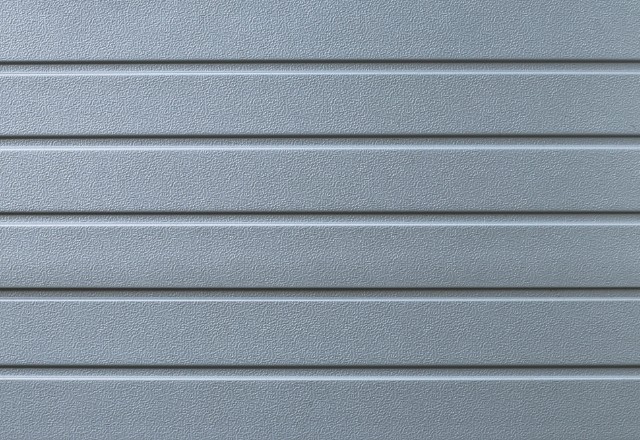
Best Metal Roofing Options for Flat Roofs
When it comes to installing a metal roof on a flat roof, there are several options to choose from. Here are some of the best metal roofing options for flat roofs:
Standing seam metal roofs
- Standing seam metal roofs are a popular choice for flat roofs because of their durability and water-resistant properties. They feature raised seams that run vertically along the roof, allowing water to drain off easily. Standing seam roofs are also easy to install and can be customized to fit the specific needs of your building.
- One of the biggest advantages of standing seam metal roofs is their seamless design. Because the panels are joined together with raised seams, there are no exposed fasteners or horizontal seams that can allow water to penetrate the roof. This seamless design provides better water resistance and helps prevent leaks.
Mechanically seamed metal panels
- Mechanically seamed metal panels are another great option for flat roofs. These panels are installed using a specialized machine that crimps the panels together, creating a tight, waterproof seal. The installation process involves fastening the panels to the roof deck and then using the machine to seam them together.
- Because mechanically seamed metal panels are installed using a machine, they provide enhanced durability and leak protection compared to other types of metal roofing. The tight, crimped seams create a virtually impenetrable barrier against water, wind, and other elements.
Flat-lock metal roofs
- Flat-lock metal roofs are a unique option for flat roofs. They feature a special interlocking system that allows the panels to be installed without any exposed fasteners or seams. The panels are joined together using a special clip system that creates a tight, waterproof seal.
- One of the biggest advantages of flat-lock metal roofs is their sleek, modern appearance. Because there are no exposed fasteners or seams, the roof has a smooth, clean look that can enhance the overall aesthetic of your building. Flat-lock metal roofs are also available in a variety of colors and finishes, allowing you to customize the look of your roof to match your building’s style.

What Are the “Downsides” of Metal Flat Roofs?
While metal roofs can be an excellent choice for flat roofs, there are some potential downsides to consider.
Potential for noise during heavy rain or hail
One potential downside of metal roofs is the potential for noise during heavy rain or hail. Because metal is a harder material than other roofing options, it can create more noise when hit by rain or hail. This can be especially noticeable on a flat roof where the sound can reverberate throughout the building.
To mitigate this issue, consider adding insulation or a soundproofing underlayment to your metal roof. This can help absorb some of the noise and make it less noticeable inside the building.
Higher initial installation costs compared to other flat roofing materials
Another potential downside of metal roofs is the higher initial installation costs compared to other flat roofing materials. While metal roofs can be a more cost-effective option in the long run due to their durability and energy efficiency, the upfront costs can be higher than other options like TPO or EPDM.
Initial installation costs and long-term costs of metal roofing with other common flat roofing materials:
Roofing Material | Initial Installation Cost (per sq. ft.) | Expected Lifespan (years) | Maintenance Costs (per sq. ft. per year) | Long-term Costs (50 years) |
Metal (Standing Seam) | $7 – $14 | 50+ | $0.05 – $0.10 | $9.50 – $19 |
TPO (Thermoplastic Polyolefin) | $5 – $8 | 20-30 | $0.10 – $0.15 | $15 – $23.50 |
EPDM (Ethylene Propylene Diene Monomer) | $4 – $7 | 20-30 | $0.10 – $0.15 | $14 – $22.50 |
Modified Bitumen | $4 – $6 | 15-20 | $0.15 – $0.20 | $19.50 – $28 |
Built-Up Roof (BUR) | $5 – $8 | 15-20 | $0.15 – $0.20 | $20.50 – $31 |
This table provides a comprehensive comparison of metal roofing with other flat roofing materials, considering both initial installation costs and long-term costs over a 50-year period:
- Initial installation costs are represented as a range of prices per square foot, with metal roofing having the highest upfront costs compared to TPO, EPDM, Modified Bitumen, and Built-Up Roof (BUR) systems.
- The expected lifespan of each roofing material is provided, with metal roofing having the longest lifespan of 50+ years, while the other materials range from 15 to 30 years.
- Maintenance costs are shown as a range of prices per square foot per year, with metal roofing having the lowest maintenance costs compared to the other materials.
- Long-term costs are calculated over a 50-year period, considering both the initial installation costs and the cumulative maintenance costs. The range of long-term costs for metal roofing is $9.50 to $19 per square foot, which is lower than the other materials.
Possible condensation issues if not properly ventilated
Another potential issue with metal roofs on flat roofs is the possibility of condensation if the roof is not properly ventilated. Because metal is a conductive material, it can allow heat to transfer more easily than other roofing materials. If the roof is not properly ventilated, this can lead to condensation buildup underneath the roof, which can cause damage to the building’s structure over time.
To prevent condensation issues, make sure your metal roof is properly ventilated. This may involve installing vents or other ventilation systems to allow air to circulate freely underneath the roof.
How many vents do you need?
Roof Area (sq. ft.) | Minimum Number of Vents |
Up to 500 | 1 |
501 – 1,000 | 2 |
1,001 – 1,500 | 3 |
1,501 – 2,000 | 4 |
2,001 – 2,500 | 5 |
2,501 – 3,000 | 6 |
3,001 – 3,500 | 7 |
3,501 – 4,000 | 8 |
4,001 – 4,500 | 9 |
4,501 – 5,000 | 10 |
Each additional 500 | Add 1 vent |
It’s important to note that these are general guidelines, and the actual number of vents required may vary based on factors such as local building codes, climate conditions, and the specific metal roofing system being used. Always consult with a professional roofing contractor and follow the manufacturer’s recommendations for proper ventilation.
When installing vents, consider the following:
- Place vents evenly along the roof to promote uniform air circulation.
- Use a combination of ridge vents, gable vents, and soffit vents to create a balanced ventilation system.
- Ensure that the vents are sized appropriately for the roof area and are compatible with the metal roofing system.
- Consider using moisture barriers and insulation to further prevent condensation buildup.
By providing adequate ventilation based on the roof area, you can minimize the risk of condensation issues and ensure the long-term performance and durability of your metal roof on a flat roof.
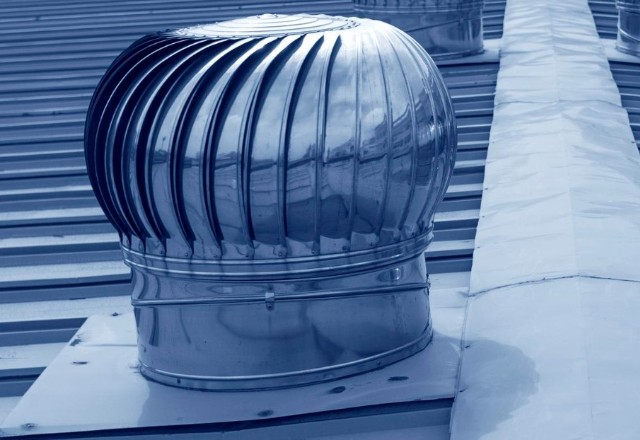
Installation Process for Metal Roofs on Flat Roofs
Installing a metal roof on a flat roof requires careful planning and attention to detail. Here’s an overview of the installation process:
Preparation and inspection of the existing flat roof
Before installing a metal roof on a flat roof, it’s important to thoroughly inspect the existing roof for any damage or issues that need to be addressed. This may involve removing the old roofing material, repairing any damage to the roof deck, and ensuring that the roof is properly sloped for drainage.
Creating proper slope and drainage
As mentioned earlier, proper slope and drainage are critical for a successful metal roof installation on a flat roof. This may involve adding tapered insulation or creating a sloped roof deck to ensure that water can drain off the roof properly.
Installing underlayment and waterproofing membranes
Once the roof deck is prepared, the next step is to install an underlayment and waterproofing membrane. This layer provides an extra barrier of protection against water and helps prevent leaks. Make sure to choose a high-quality underlayment that is compatible with your metal roofing system.
Securing metal panels and ensuring proper seaming
With the underlayment in place, it’s time to install the metal panels. The specific installation process will vary depending on the type of metal roofing system you choose, but it typically involves securing the panels to the roof deck using fasteners or clips and then seaming the panels together to create a watertight seal.
It’s important to follow the manufacturer’s instructions carefully and ensure that the panels are properly aligned and secured. Any gaps or mistakes in the installation process can lead to leaks and other issues down the road.
Adding ventilation and insulation if necessary
Depending on your specific building and climate, you may need to add ventilation and insulation to your metal roof system. Proper ventilation helps prevent condensation and moisture buildup, while insulation can help improve energy efficiency and reduce noise.
Final inspection and maintenance guidelines
Once the metal roof is installed, it’s important to conduct a final inspection to ensure that everything is properly secured and sealed. Your roofing contractor should also provide you with maintenance guidelines to help keep your metal roof in top condition for years to come.
Regular maintenance may involve cleaning the roof to remove debris, inspecting the seams and fasteners for any signs of wear or damage, and making any necessary repairs promptly. With proper maintenance, your metal roof can provide reliable protection for your flat roof for decades.
In conclusion, installing a metal roof on a flat roof can be an excellent investment for your building, providing durability, energy efficiency, and long-lasting protection against the elements. By choosing the right metal roofing system, ensuring proper installation, and following regular maintenance guidelines, you can enjoy the benefits of a metal roof on your flat roof for years to come. Don’t hesitate to consult with a professional roofing contractor to discuss your options and find the best solution for your specific needs.
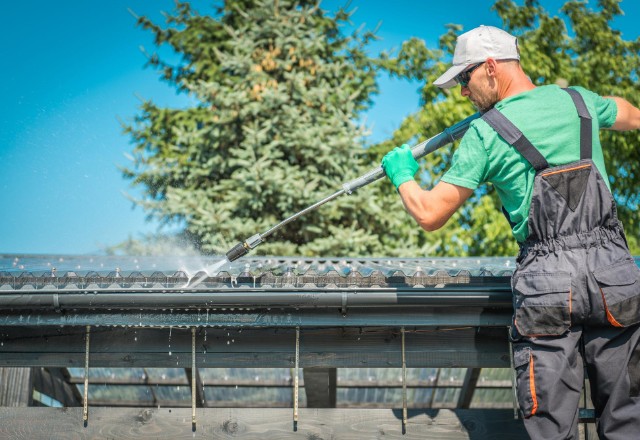
Choosing Metal Roofing
When it comes to choosing metal roofing for your flat roof, there are several important factors to consider. Let’s dive into the details:
Can you put metal on a flat roof?
Yes, you can put metal on a flat roof! While metal roofs are more commonly associated with sloped roofs, they can be adapted for use on flat roofs as well. Metal roofs can be an excellent choice for flat roofs due to their durability, energy efficiency, and low maintenance requirements.
What if a metal roof isn’t right for your flat roof?
While metal roofs can be a great option for many flat roofs, they may not be the best choice for every building. Here are a few situations where a metal roof may not be the right fit:
- If your building is located in an area with extreme weather conditions, such as heavy snow or high winds, a metal roof may not provide sufficient protection.
- If your building has a low slope or poor drainage, a metal roof may be unable to shed water effectively, leading to ponding and other issues.
- If your building has a historical or architectural significance that requires a specific type of roofing material, a metal roof may not be an appropriate choice.
How much will it cost to install a metal roof on your flat roof?
The cost of installing a metal roof on your flat roof will vary depending on several factors, including the size of your roof, the type of metal roofing material you choose, and the complexity of the installation process. On average, you can expect to pay between $7 and $14 per square foot for a metal roof installation on a flat roof.
While this may be more expensive than other flat roofing materials upfront, it’s important to consider the long-term cost savings of a metal roof. Metal roofs can last up to 50 years or more with proper maintenance, while other flat roofing materials may need to be replaced every 10-20 years. Additionally, metal roofs can provide significant energy savings by reflecting heat and reducing cooling costs.
Conclusion
In conclusion, installing a metal roof on a flat roof can be an excellent investment for your building, providing durability, energy efficiency, and long-lasting protection against the elements. While there are some important factors to consider, such as proper installation, slope, and drainage, a metal roof can be a viable and beneficial option for many flat roofs.
Of course, installing a metal roof on a flat roof is not a DIY project. It requires specialized knowledge, skills, and equipment to ensure proper installation and long-term performance. That’s why we strongly recommend consulting with professional roofing contractors who specialize in metal roofs on flat roofs.
A professional roofing contractor can help you:
- Assess the feasibility and suitability of a metal roof for your specific building and needs
- Choose the best metal roofing system and materials for your flat roof
- Ensure proper installation, slope, and drainage to prevent issues like ponding water and leaks
- Provide regular maintenance and repairs to keep your metal roof in top condition for years to come
So if you’re considering a metal roof for your flat roof, don’t hesitate to reach out to a professional roofing contractor today. They can provide you with a free consultation and estimate, and help you make an informed decision about the best roofing option for your building.
At the end of the day, a metal roof on a flat roof can be a smart, long-term investment that provides reliable protection, energy efficiency, and aesthetic appeal. With the right installation and maintenance, a metal roof can help keep your building safe, comfortable, and looking great for years to come.
Frequently Asked Questions
Still have questions about installing a metal roof on your flat roof? Here are some frequently asked questions and answers to help you make an informed decision:



 509-201-4190
509-201-4190
